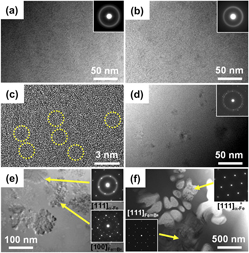Crossref Citations
This article has been cited by the following publications. This list is generated based on data provided by
Crossref.
Park, H. J.
Kim, Y. S.
Hong, S. H.
Kim, J. T.
Cho, J. Y.
Lee, W. H.
and
Kim, K. B.
1970.
Formation of Nano-oxides on Porous Metallic Glass Compacts using Hydrothermal Synthesis.
journal of Korean Powder Metallurgy Institute,
Vol. 22,
Issue. 4,
p.
229.
Park, J.M.
Kim, D.H.
and
Eckert, J.
2012.
Internal state modulation-mediated plasticity enhancement in monolithic Ti-based bulk metallic glass.
Intermetallics,
Vol. 29,
Issue. ,
p.
70.
Park, Jin Man
Kim, Tae Eung
Kim, Suk Jun
Kim, Won Tae
Kühn, Uta
Eckert, Jürgen
and
Kim, Do Hyang
2012.
Improving the Mechanical Properties of Fe-Nb-(Ni-Mn) Dendrite-Ultrafine Eutectic Composites via Controlling the Primary Phase Features.
Metallurgical and Materials Transactions A,
Vol. 43,
Issue. 8,
p.
2680.
Park, Jin Man
Han, Jun Hee
Mattern, Norbert
Kim, Do Hyang
and
Eckert, Jurgen
2012.
Designing Zr-Cu-Co-Al Bulk Metallic Glasses with Phase Separation Mediated Plasticity.
Metallurgical and Materials Transactions A,
Vol. 43,
Issue. 8,
p.
2598.
Zhao, Chengliang
Dun, Chaochao
Man, Qikui
and
Shen, Baolong
2013.
Enhancement of plastic deformation in FeCoNbB bulk metallic glass with superhigh strength.
Intermetallics,
Vol. 32,
Issue. ,
p.
408.
Hong, Sung Hwan
Kim, Jeong Tae
Lee, Min Woo
Park, Jin Man
Lee, Min Ha
Kim, Bum Sung
Park, Jun Young
Seo, Yongho
Suh, Jin Yoo
Yu, Peng
Qian, Ma
and
Kim, Ki Buem
2014.
Combinatorial Influence of Bimodal Size of B2 TiCu Compounds on Plasticity of Ti-Cu-Ni-Zr-Sn-Si Bulk Metallic Glass Composites.
Metallurgical and Materials Transactions A,
Vol. 45,
Issue. 5,
p.
2376.
Cho, Jae Young
Park, Hae Jin
Hong, Sung Hwan
Kim, Jeong Tae
Kim, Young Seok
Park, Jun-Young
Lee, Naesung
Seo, Yongho
Park, Jin Man
and
Kim, Ki Buem
2015.
Designing porous metallic glass compact enclosed with surface iron oxides.
Journal of Alloys and Compounds,
Vol. 635,
Issue. ,
p.
233.
Guo, Shengfeng
and
Su, Chen
2017.
Micro/nano ductile-phases reinforced Fe-based bulk metallic glass matrix composite with large plasticity.
Materials Science and Engineering: A,
Vol. 707,
Issue. ,
p.
44.
Li, H.X.
Lu, Z.C.
Wang, S.L.
Wu, Y.
and
Lu, Z.P.
2019.
Fe-based bulk metallic glasses: Glass formation, fabrication, properties and applications.
Progress in Materials Science,
Vol. 103,
Issue. ,
p.
235.
Liu, C.Y.
Zhang, Y.X.
Yuan, G.
Zhang, C.Y.
Kang, J.
and
Misra, R.D.K.
2022.
Crystallization behavior and properties characterization for high-energy state FeSiBCuC metallic glass produced by strip casting.
Materials Science and Engineering: A,
Vol. 837,
Issue. ,
p.
142753.
Park, Hae Jin
Lee, Hee Jin
Kim, Tae Kyung
Hong, Sung Hwan
Wang, Wei-Min
Choi, Taek Jib
and
Kim, Ki Buem
2022.
Formation of photo-reactive heterostructure from a multicomponent amorphous alloy with atomically random distribution.
Journal of Materials Science & Technology,
Vol. 109,
Issue. ,
p.
245.
Chu, Zhenhua
Fan, Yi
Zhang, Yunzheng
and
Xu, Yucheng
2024.
Comprehensive Materials Processing.
p.
245.
Amigo, Nicolás
2024.
Modulation of plasticity by crystalline precipitates in CuZr metallic glasses.
Materials Today Communications,
Vol. 39,
Issue. ,
p.
109018.
Li, W.
Wang, C.
Li, L.Y.
Zhang, C.
Ma, J.
Xi, X.K.
Tao, K.
Qiao, J.C.
Yuan, C.C.
and
Wang, W.H.
2025.
Manipulating defects in metallic glasses via ultrasonic treatment.
International Journal of Mechanical Sciences,
Vol. 287,
Issue. ,
p.
109960.



